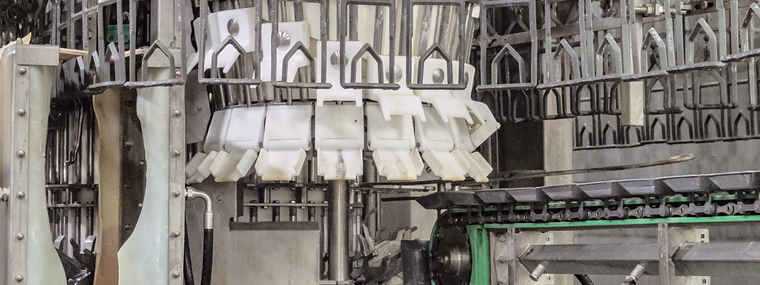
Cleaning Meat and Poultry Processing Plants
By Diane M. Calabrese / Published September 2020

White-glove-test ready may overstate it a bit, but that’s how many supervisors and employees inside meat and poultry processing plants view the expectations of the Food Safety and Inspection Service (FSIS).
FSIS is part of the U.S. Department of Agriculture (USDA). Its purview encompasses safety and accurate labeling of meat, poultry, and processed egg products. And, it enforces rules deriving from federal acts governing humane slaughter and handling (the processing) of food animals.
Like other compliance-enforcing federal entities, FSIS puts the onus for getting it right on the industry player. To attain eligibility for FSIS inspection (and meet USDA certification requirements), a plant (processing and/or slaughter) must have standard procedures for sanitation in place.
Development of an HACCP [hazard analysis and critical control point] plan is required. FSIS does not just inspect equipment and structures. It also inspects carcasses.
Members of our industry serve the needs of the meat and poultry processing in many ways. For example, they may provide design advice for potable and wastewater systems inside plants. Or, they may be called to help with a comprehensive cleanup and disinfection after a disease outbreak among chickens.
Yujin Yoo Anderson, general manager at Steamericas Inc. in East Inglewood, CA, gives us an example of how equipment from her company is used. “The benefit of the Optima Steamer is best seen in locations where meat is conveyed after processing and flash freezing,” she explains. “It melts grease and other materials quickly—due to temperature—and pushes and moves the materials from the surfaces that you are cleaning without the introduction of large volumes of water.”
After consulting with one of her company’s dealers, Glen Williams of PSI in Westminster, CA, Anderson relays one of the unintended (and unwanted) outcomes in the processing plant setting when cleaning is not done in proper sequence. “Cleaning 101 suggests dry cleaning—removing chunks—should be done first, then wet cleaning, and lastly controlled cleaning,” she says.
“Dry cleaning must be done properly before steam can be applied,” explains Anderson. “The larger meat chunks that remain when cleaning hasn’t been done properly will turn into cooked meat when hot water or dry steam gets introduced prematurely.”
Owners of meat and poultry processing plants develop their own protocols for cleaning. Manufacturers of processing tools may have recommendations. But with liability stakes so high for plant owners—think shutdowns because of Salmonella-contaminated meat (or eggs)—owners make the decisions about how.
Getting things right is a constant goal of researchers in the industry. Continuous cleaning of conveyors in poultry processing plants has been tried using 113°F (45°C) water. Research, however, points to no significant difference in the number of microorganisms on belts cleaned continuously and those cleaned non-continuously.
Individuals who hunt and dress their own deer and fowl have a good idea of how the sequence in processing plants goes. They may be surprised by some of the most specific restrictions to which the plants comply.
Consider SRM rules, which refers to a specified risk material. Tissues that may contain the prion associated with bovine spongiform encephalopathy (BSE), aka mad cow disease, must be separated from cattle. These are brain, skull, eyes, terminal ganglia, spinal cord, vertebral column, and dorsal root ganglia of cattle older than 30 months. Tonsils must be removed from all cattle.
A variant of BSE, Creutzfeldt-Jakob Disease, may also be thwarted by strict SRM policies. Its etiology is not entirely clear, though.
Employees of meat and poultry processing plants have enormous responsibility for keeping the food supply safe. In an effort to make plants safer for employees, robotic cutting is becoming more common; and one day employees of plants may do more monitoring of equipment and little hands-on work.
The USDA issued a global outlook for livestock and poultry markets on July 10, 2020. The outlook shows strong demand for meat with a small decline. USDA estimates that 100 million tons of chicken meat will be produced globally in 2020.
As a reliable source of protein, meat is an essential food source. Pauses at some U.S. processing plants in spring because workers fell ill was a concern. By the second week of June, however, plants were operating at 95 percent or more of capacity (compared to 2019).
Scope of Sanitation
FSIS has set standards for every conceivable component of meat and poultry processing plants—from lights to employee hygiene and from batteries to scalding pans. Operational sanitation is just one component. Some highlights are presented in this section.
Information that follows derives from the FSIS guide to performance standards compliance which can be viewed at www.fsis.usda.gov/wps/portal/fsis/topics/regulatory-compliance/compliance-guides-index/sanitation-performance-standards/sanitation-guide-appendices.
Water must be potable and easily accessed. In some parts of the plant, where there is no chance of it interacting with edible product, non-potable water may be present. Floors must be washed with potable water.
If non-potable water is available, lines to it must be clearly marked. Reuse of water, potable or non-potable, is extremely limited. If reuse is permitted, it must be for an identical purpose.
Water for cleaning equipment, floors, and walls must be available at 180°F. The water is to be delivered under sufficient pressure to allow cleaning. (This, of course, is one place where some members of our industry find a niche they can serve, particularly with customized solutions.)
Drainage lines cannot be mixed. Toilet drainage and plant drainage lines must be well-separated and located far outside a building. (Cleaning the toilet and workers’ changing areas is a possible opportunity for contractors.)
Utensils and scabbards for knives must be kept clean. Special washers for utensils are an opportunity for parts-washer manufacturers. Impervious and rust-resisting metal used in scabbards may allow them to be cleaned using a pressure washer.
Barrels and tubs, catch basins outside the plants, and mechanical feather pickers must be cleaned, too.
Some plants do not have conveyors. Instead, processing trays are used. The trays must be cleaned as well as receptacles used for offal and condemned carcasses. There are plenty of opportunities for contract cleaners inside plants, especially smaller facilities. Inquire at local plants about how to secure regular or as-needed cleaning work.
No-nonsense epidemiologists sometimes refer to the entire world being covered with a thin veneer of feces. Well, there are perhaps no places with more of that layer than meat and poultry plants at the slaughter end. The feces— manure—must be removed, and the areas with accumulation cleaned daily. Many of our readers who do contract cleaning and have worked in meat and poultry processing plants know that cleaning residential and commercial building exteriors is quite a different experience.
Thinking too deeply about the origin of the meat that becomes a meal may cause difficulty for the queasier among us. There’s something to the philosophy of eating only what one kills.
And there is something to the idea of taking raw meat and searing it with an open flame. It’s a way to kill bacteria and other microorganisms that can cause gastrointestinal problems or worse.
It’s not easy to keep vermin out of plants. Rats, flies, and mice are adaptable and clever. Any breach in a floor or wall is a route of entry for rodents. Cleaning and sanitation help keep them out, but it’s only a reduction. There’s a reason the USDA allows certain number of rodent and insect remains in food products deemed safe. One hundred percent elimination is not possible.
Cleaners, or chemicals, used inside plants must meet all safety expectations for any setting. Their residues must not contaminate food.
Water treatment methods for potable water used inside processing plants is a big issue. Companies that design plants and treatment systems must follow standards for chemical use. Chemicals must be considered GRAS [generally recognized as safe] by the U.S. Food and Drug Administration.
OSHA Perspective
The Occupational Safety and Health Administration (OSHA) eTool for its job category of sanitation work in poultry processing illustrates the scope of difficulties of the setting. (See www.osha.gov/SLTC/etools/poultry/sanitationworker.html.) The sanitation crew cleans machinery and floors.
The onus on the crews—get it wrong and FSIS can stop the next production shift—is enormous. The crews use tools ranging from squeegees to water under pressure. OSHA notes that many crews are contracted and not employees of the plant.
Contractors that take on work in meat and poultry processing plants must follow all lockout and tag procedures they would on any jobsite. That means they must be sure to have complete familiarity with the electric connections and switch boxes in the facility.
Lockout and tag procedures are also important because of the danger some of the equipment in a facility poses if accidentally turned on. OSHA details a fatality involving a feather-picking machine that we will just leave at that.
We are not sure about the white-glove test. But the individuals who work in meat and poultry processing plants to keep them clean and operating optimally, despite some tough sanitation issues, most definitely deserve to be put in the category of those who wear white hats.






